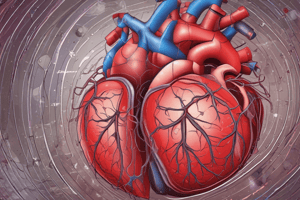Podcast
Questions and Answers
In the context of hypertensive emergencies, which of the following best describes 'end-organ damage'?
In the context of hypertensive emergencies, which of the following best describes 'end-organ damage'?
- A temporary elevation in blood pressure without any lasting effects on major organs.
- The psychological stress experienced by patients due to the diagnosis of hypertension.
- A condition where the patient experiences a sudden drop in blood pressure leading to organ failure.
- Damage to vital organs, such as the brain, heart, or kidneys, resulting from severely elevated blood pressure. (correct)
Which of the following is the MAIN differentiating factor between a hypertensive emergency and a hypertensive urgency?
Which of the following is the MAIN differentiating factor between a hypertensive emergency and a hypertensive urgency?
- The presence of end-organ damage in hypertensive emergency. (correct)
- The severity of the blood pressure reading.
- The use of IV medications for blood pressure control.
- The patient's self-reported symptoms.
A patient presents with a blood pressure of 200/130 mmHg and reports a severe headache, blurred vision, and chest pain. Which of the following is the MOST appropriate initial step?
A patient presents with a blood pressure of 200/130 mmHg and reports a severe headache, blurred vision, and chest pain. Which of the following is the MOST appropriate initial step?
- Immediately reduce the blood pressure to the patient's baseline to prevent further complications.
- Administer oral antihypertensive medication to gradually lower blood pressure over 24-48 hours.
- Assess for end-organ damage to differentiate between hypertensive emergency and urgency. (correct)
- Reassure the patient and advise lifestyle modifications to manage blood pressure.
What is the general recommendation for the initial reduction of blood pressure in the first hour of treating a hypertensive emergency?
What is the general recommendation for the initial reduction of blood pressure in the first hour of treating a hypertensive emergency?
Which set of signs and symptoms would MOST strongly suggest hypertensive encephalopathy?
Which set of signs and symptoms would MOST strongly suggest hypertensive encephalopathy?
A patient with known cocaine use presents with significantly elevated blood pressure. Which class of medications is generally AVOIDED in this situation, and why?
A patient with known cocaine use presents with significantly elevated blood pressure. Which class of medications is generally AVOIDED in this situation, and why?
Which of the following is LEAST likely to be associated with acute kidney injury secondary to hypertensive crisis?
Which of the following is LEAST likely to be associated with acute kidney injury secondary to hypertensive crisis?
What physical exam findings would be MOST concerning for aortic dissection in a patient presenting with chest pain and hypertension?
What physical exam findings would be MOST concerning for aortic dissection in a patient presenting with chest pain and hypertension?
Which historical factor is MOST important to ascertain when evaluating a patient with severe hypertension in the emergency department?
Which historical factor is MOST important to ascertain when evaluating a patient with severe hypertension in the emergency department?
In pregnant patients with severe hypertension, which of the following conditions should be considered and managed with IV magnesium?
In pregnant patients with severe hypertension, which of the following conditions should be considered and managed with IV magnesium?
Which of the following statements correctly reflects the management approach for asymptomatic patients with elevated blood pressure (hypertensive urgency)?
Which of the following statements correctly reflects the management approach for asymptomatic patients with elevated blood pressure (hypertensive urgency)?
Which of the following assessment findings is MOST indicative of hypertensive retinopathy during fundoscopic examination?
Which of the following assessment findings is MOST indicative of hypertensive retinopathy during fundoscopic examination?
Why is it important to avoid precipitous drops in blood pressure in patients with chronic hypertension?
Why is it important to avoid precipitous drops in blood pressure in patients with chronic hypertension?
What is the most crucial aspect of managing a patient with hypertension and chest pain?
What is the most crucial aspect of managing a patient with hypertension and chest pain?
A patient presents with acute shortness of breath and is subsequently diagnosed with cardiogenic pulmonary edema. Which of the following signs and symptoms would be MOST consistent with this diagnosis?
A patient presents with acute shortness of breath and is subsequently diagnosed with cardiogenic pulmonary edema. Which of the following signs and symptoms would be MOST consistent with this diagnosis?
What is the initial blood pressure goal over the first 2-6 hours for a patient in hypertensive emergency without aortic dissection or stroke?
What is the initial blood pressure goal over the first 2-6 hours for a patient in hypertensive emergency without aortic dissection or stroke?
A patient with pre-eclampsia is at risk for developing HELLP syndrome. What does HELLP stand for?
A patient with pre-eclampsia is at risk for developing HELLP syndrome. What does HELLP stand for?
What is the primary lab test to evaluate for proteinuria in a patient with hypertensive emergency?
What is the primary lab test to evaluate for proteinuria in a patient with hypertensive emergency?
A patient with a history of hypertension presents with chest pain, and their blood pressure is elevated. Why is it important to take a thorough history and perform a physical exam rather than immediately focusing solely on lowering the blood pressure?
A patient with a history of hypertension presents with chest pain, and their blood pressure is elevated. Why is it important to take a thorough history and perform a physical exam rather than immediately focusing solely on lowering the blood pressure?
Which of the following statements best exemplifies the concept of 'measuring what is important' in the context of hypertensive crisis management?
Which of the following statements best exemplifies the concept of 'measuring what is important' in the context of hypertensive crisis management?
Flashcards
Hypertensive Crisis
Hypertensive Crisis
Acute elevation of blood pressure with SBP>180 and/or DBP>120. Divided into hypertensive emergency and urgency.
Hypertensive Emergency
Hypertensive Emergency
Hypertensive crisis + end-organ damage. Organs: kidneys, eyes, heart, lungs, brain, vasculature, uterus.
Hypertensive Urgency
Hypertensive Urgency
Hypertensive crisis without end-organ damage. No benefit from rapid BP reduction; can cause harm.
Kidney Damage (Hypertension)
Kidney Damage (Hypertension)
Signup and view all the flashcards
Hypertensive Retinopathy Signs
Hypertensive Retinopathy Signs
Signup and view all the flashcards
Cardiogenic Pulmonary Edema Signs
Cardiogenic Pulmonary Edema Signs
Signup and view all the flashcards
Hypertensive Encephalopathy Signs
Hypertensive Encephalopathy Signs
Signup and view all the flashcards
Microangiopathic Hemolytic Anemia Signs
Microangiopathic Hemolytic Anemia Signs
Signup and view all the flashcards
Treating Asymptomatic Hypertension
Treating Asymptomatic Hypertension
Signup and view all the flashcards
Cocaine-Associated Hypertension
Cocaine-Associated Hypertension
Signup and view all the flashcards
Pre-eclampsia / Eclampsia Symptoms
Pre-eclampsia / Eclampsia Symptoms
Signup and view all the flashcards
HELLP Syndrome Symptoms
HELLP Syndrome Symptoms
Signup and view all the flashcards
Aortic Dissection Symptoms
Aortic Dissection Symptoms
Signup and view all the flashcards
Lowering BP Too Rapidly
Lowering BP Too Rapidly
Signup and view all the flashcards
Study Notes
Classic ED Hypertension Cases
- Common presentations include patients who took their blood pressure at a store like Wal-Mart
- Some complain of a headache when their blood pressure is high or because they know their blood pressure is high
- Others may state they were sent from their doctor's office, or have concerns about a stroke, or complain of stomach pain
Hypertensive Crisis
- Defined as acute elevation of blood pressure with SBP>180 and/or DBP>120
- Subdivided into hypertensive emergency and urgency
Hypertensive Emergency
- A hypertensive crisis with subsequent end-organ damage
Hypertensive Urgency
- Considered a controversial term
- Essentially a hypertensive crisis without end-organ damage
- There is no clinical benefit to rapid blood pressure reduction, and it can cause real harm
End-Organ Damage: Kidneys
- Acute Kidney Injury can occur
- Signs and symptoms include peripheral edema, oliguria, loss of appetite, nausea/vomiting, orthostatic changes, and confusion
- Testing includes UA for proteinuria and Chem for elevated BUN/Creatinine
End-Organ Damage: Eyeballs
- Hypertensive retinopathy can occur
- Signs and symptoms include vision changes, splinter hemorrhages, cotton-wool spots, and headache
End-Organ Damage: Heart
- Can result in Acute Coronary Syndrome (ACS) / Myocardial Infarction (MI)
- Testing includes same tests
End-Organ Damage: Lungs
- Can result in cardiogenic pulmonary edema
- Signs and symptoms include shortness of breath, cough, hypoxia, tachypnea, and abnormal lung sounds
- Testing includes CXR
End-Organ Damage: Brain
- Can result in hypertensive encephalopathy or hemorrhagic stroke
- Signs and symptoms include: hemorrhagic stroke, facial droop, arm drift, speech abnormalities, hypertensive encephalopathy, and altered mental status
- Testing includes CT head
End-Organ Damage: Vasculature
- Can result in aortic dissection or microangiopathic hemolytic anemia
- Aortic Dissection: Signs and symptoms include chest pain plus altered mental status, abdominal pain, and pulse/BP deficit Testing includes aortic dissection, CT, and ultrasound
- Microangiopathic hemolytic anemia includes signs and symptoms of tissue ischemia/necrosis, seizure, stroke, focal neurologic deficits, and acute renal injury
- Testing includes CBC, CMP, and UA
End-Organ Damage: Uterus
- Can result in Pre-eclampsia / eclampsia and HELLP
- Pre-eclampsia and eclampsia: Signs and symptoms include edema, shortness of breath, headache, and vision changes Testing includes UA, CBC, CMP, Liver enzymes, and CXR
- Hemolysis Elevated Liver enzymes Low Platelet count (HELLP): Signs and Symptoms include epigastric/RUQ pain/tenderness, and nausea/vomiting
- Testing includes CBC, LFT, CMP, and UA
Hypertensive Crisis Workup
- Base it on history and physical, not just the blood pressure reading, and recheck the blood pressure
- Check for pregnancy in anyone pregnancy-capable
- Obtain a SAMPLE history: "Do you have high blood pressure?" and "What medications do you take daily?"
- Perform a good review of systems: chest pain, SOB, weakness, slurring, numbness, clumsiness, vision changes, nausea/vomiting, headache, palpitations, diaphoresis
ACEP Policy Statement
- Laboratory testing for asymptomatic patients with elevated BP should not be considered routinely but may be helpful in select patients
Management
- Treat the end-organ appropriately and bring down the BP appropriately if the patient has a true hypertensive emergency
- Reduce BP by no more than 25% in the first hour, with a goal of 160/100 over the next 2-6 hours, and normal over 24-48 hours
- Aortic dissection, acute intracerebral hemorrhage, and severe pre-eclampsia / eclampsia require more aggressive management
- Labetalol is a good first choice in most cases
- Avoid beta blockers in cocaine-associated hypertension, use hydralazine instead
- HELLP and eclampsia get IV magnesium
Management of Asymptomatic High Blood Pressure (Hypertensive Urgency)
- Acute treatment of asymptomatic severe hypertension does not prevent or reduce short-term patient morbidity or mortality
- Many with markedly elevated blood pressure have chronic hypertension and have lost cerebral autoregulation and rely on high blood pressure to perfuse their brain and heart
- Acutely decreasing blood pressure can cause ischemic stroke or MI
- When prescribing outpatient antihypertensives, follow JNC guidelines if they do not have PCP or good follow up
- If you are choosing an ACE inhibitor, check creatinine and potassium first
- Those that received an antihypertensive prescription had fewer 30-day returns and adverse events, but the limitations are that it was not an RCT and had possible confounders
Take-Home Points
- Hypertension in the ED is a sign, not a condition
- If you have a hypertensive patient with chest pain, they are a "chest pain patient," not a "hypertension patient."
- Do not acutely lower a patient's blood pressure if they don't have a hypertensive emergency
- Rely on good history and physical
- Arrange for primary care follow-up for hypertensive patients
Studying That Suits You
Use AI to generate personalized quizzes and flashcards to suit your learning preferences.




